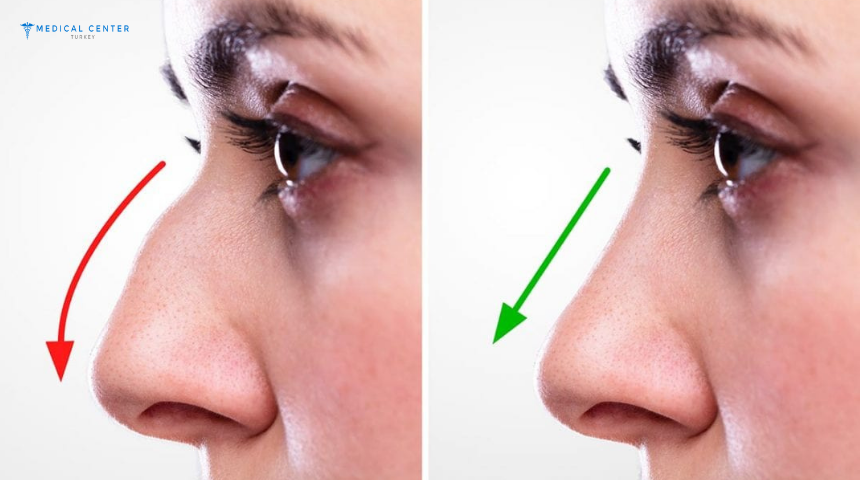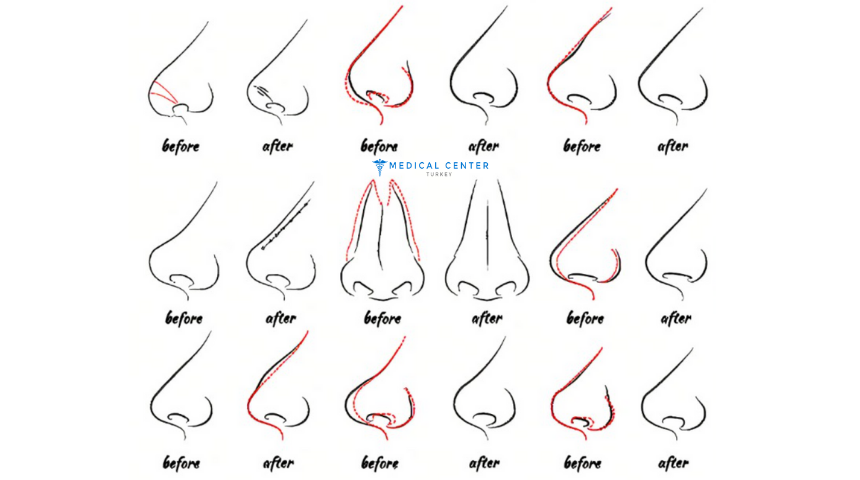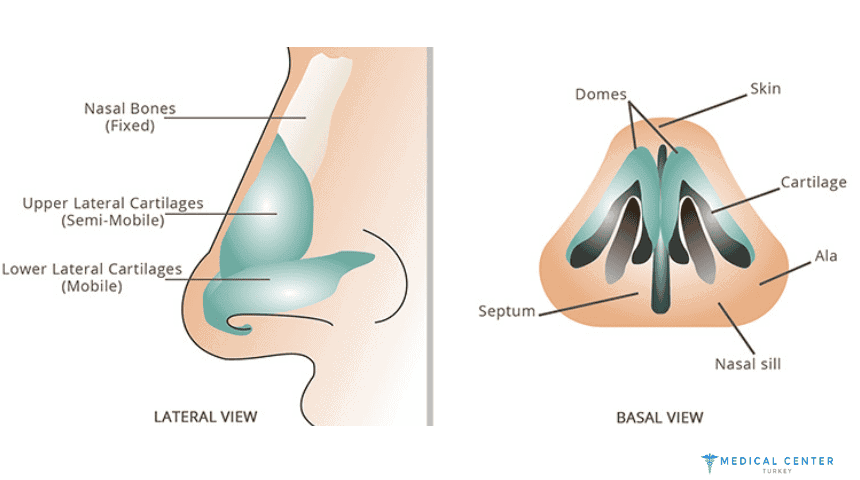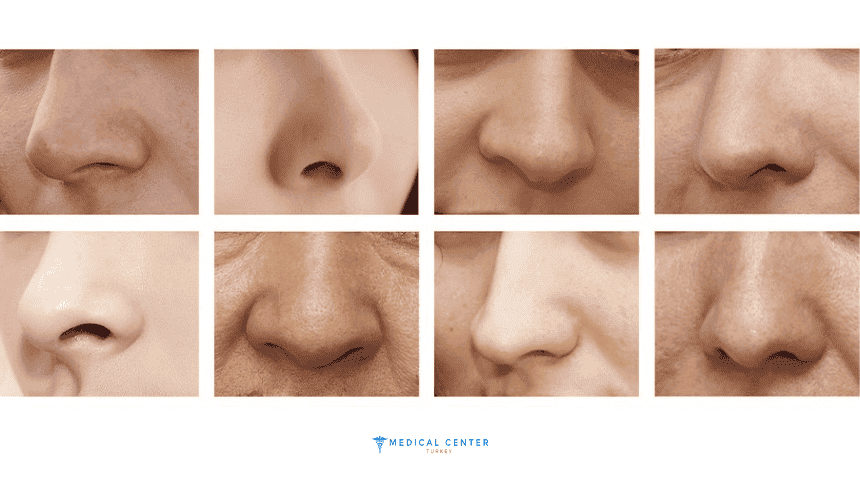What Are the Differences Between Rhinoplasty Options in 2025?
What Are the Differences Between Rhinoplasty Options in 2025 is an article that aims to give you all the information you do not know about What Are the Differences Between Rhinoplasty Options in 2025 and more. We kindly shared the main headings with you;
What is Rhinoplasty Surgery?
Rhinoplasty is a surgical procedure aimed at altering the shape or structure of the nose. It can be performed for both cosmetic and functional reasons:
Cosmetic Rhinoplasty: This type of surgery is done to improve the appearance of the nose. It may involve reshaping the nasal tip, reducing or augmenting the size of the nose, or correcting asymmetry.
Functional Rhinoplasty: This type is typically performed to correct breathing issues caused by structural problems such as a deviated septum, nasal obstruction, or other abnormalities affecting airflow.
The procedure can involve changes to the bone, cartilage, or soft tissue, and it can be done using either an open or closed approach. In an open rhinoplasty, an incision is made across the columella (the tissue between the nostrils), allowing the surgeon more access. In closed rhinoplasty, all incisions are made inside the nostrils, leaving no visible scars.
Recovery time varies but generally takes a few weeks for initial healing, with full results visible after several months to a year, as swelling subsides.
What are Different Types of Rhinoplasty Surgery?
Rhinoplasty procedures can be categorized into different types based on the surgical approach, the reason for the surgery (cosmetic vs. functional), and the specific techniques used. Here’s an overview of the different types of rhinoplasty procedures:
Cosmetic Rhinoplasty (Aesthetic Rhinoplasty)
- Purpose: To improve the appearance of the nose.
- Common Changes:
- Reducing or augmenting the size of the nose.
- Changing the shape of the nasal tip.
- Correcting asymmetry.
- Narrowing or widening the nostrils.
- Straightening a crooked nose.
Techniques Used:
- Reduction Rhinoplasty: Reduces the size of the nose (commonly done for large or long noses).
- Augmentation Rhinoplasty: Adds volume, typically using implants or cartilage from the patient’s body (common in cases where the nose is under-projected or a patient desires a more prominent nose).
- Tip Plasty: Focuses on reshaping or refining the tip of the nose.
Functional Rhinoplasty (Medical or Reconstructive Rhinoplasty)
- Purpose: To improve nasal function, typically to correct breathing problems caused by structural issues.
- Common Indications:
- Deviated septum (Septoplasty).
- Nasal airway obstructions (can be due to enlarged turbinates or crooked nasal passages).
- Sinus issues or chronic congestion.
- Post-traumatic deformities or previous surgery complications.
Techniques Used:
- Septoplasty: Corrects a deviated septum, improving airflow through the nasal passages.
- Turbinate Reduction: Reduces the size of the turbinates inside the nose to improve airflow.
- Nasal Valve Surgery: Addresses issues with the nasal valve, a critical area for airflow.
Primary Rhinoplasty vs. Revision Rhinoplasty
- Primary Rhinoplasty: The first-time surgery to correct nasal appearance or function.
- Revision Rhinoplasty (Secondary Rhinoplasty): Performed to correct or improve results from a previous rhinoplasty that didn’t achieve the desired outcome or has resulted in complications (such as breathing issues or cosmetic concerns).
Closed Rhinoplasty
- Technique: All incisions are made inside the nostrils, meaning there are no visible external scars.
- Benefits: Shorter recovery time, minimal visible scarring, and a more controlled procedure for less dramatic changes.
- Limitations: Limited access to the nasal structures, making it difficult to perform complex reshaping, especially on the tip of the nose.
Open Rhinoplasty
- Technique: Involves an incision across the columella (the tissue between the nostrils), providing better visibility and access to the nasal structures.
- Benefits: Ideal for more complex or extensive reshaping, such as dramatic tip alterations or significant size changes.
- Limitations: Visible scar at the base of the nose, although it typically fades over time.
Non-Surgical Rhinoplasty (Liquid Rhinoplasty)
- Purpose: A minimally invasive procedure that uses injectable fillers (such as hyaluronic acid) to alter the shape of the nose without surgery.
- Common Changes:
- Filling in depressions or bumps.
- Adding volume to the nasal bridge.
- Refining the nasal tip.
- Benefits: Quick procedure with no downtime, temporary results, and minimal risk.
- Limitations: Results are temporary (typically lasting 6-18 months), and it’s not suitable for large structural changes.
Ethnic Rhinoplasty
- Purpose: Tailored rhinoplasty that takes into account the unique nasal characteristics of different ethnic groups.
- Common Considerations:
- Maintaining ethnic identity while improving aesthetic appearance.
- For example, for people of Asian, African, or Middle Eastern descent, the goal might be to refine the nose while preserving important cultural features.
- Techniques Used: May involve augmentation, tip refinement, or nostril reshaping, depending on the specific needs of the patient.
Nasal Reconstruction (Reconstructive Rhinoplasty)
- Purpose: To reconstruct the nose after traumatic injury, cancer, or congenital deformities.
- Common Causes: Severe injury, skin cancer removal, birth defects like cleft palate, or post-surgical defects.
- Techniques Used: Often involves grafts from other parts of the body (e.g., ear cartilage, rib cartilage) to restore the shape and function of the nose.
Fascia or Cartilage Grafting
- Purpose: To add structural support, especially in cases of previous surgery, trauma, or congenital deformities.
- Techniques:
- Ear Cartilage Grafting: Cartilage taken from the ear to reshape or support the nose.
- Rib Cartilage Grafting: Cartilage harvested from the rib to provide additional structural support, especially for complex reconstructions.
Each of these procedures can be customized based on the patient’s needs, and a skilled surgeon will determine the best approach for achieving the desired aesthetic or functional outcome.
You can easily request a personalized treatment plan and receive your free quote by clicking the image below.
What is the recovery process like for different rhinoplasty methods, and how long does it take to see results?
Rhinoplasty has come a long way by 2025, offering both traditional surgical and non-surgical options tailored to each patient’s anatomy and goals. The recovery journey varies significantly depending on whether you opt for open rhinoplasty, closed rhinoplasty, or a non-surgical nose job—and understanding these differences can help set realistic expectations.
Open rhinoplasty, which involves a small incision between the nostrils, is typically chosen for more complex reshaping. Swelling and bruising are more pronounced in the first 7–10 days, and most patients return to daily life within 2 weeks. However, subtle swelling—especially at the tip of the nose—can persist for several months. Full results are often visible after 6–12 months, as the soft tissues settle and contour naturally.
In contrast, closed rhinoplasty (performed through internal incisions) generally offers a shorter recovery timeline. Since there’s no visible external incision, patients experience less swelling and typically return to normal activities in 7–10 days. While early improvements are noticeable within weeks, final results can still take 3–6 months to fully emerge.
Non-surgical rhinoplasty—using dermal fillers to smooth bumps or refine contours—requires virtually no downtime. Patients can resume most activities immediately, and results are visible right after the procedure. However, these effects are temporary and usually last between 12 to 18 months, depending on the filler used.
In all cases, following post-procedure instructions, avoiding direct sun exposure, and refraining from strenuous activities are crucial for optimal healing.
By 2025, enhanced techniques and personalized recovery plans have made rhinoplasty safer, smoother, and more predictable than ever. If you’re considering the best method for your needs, our Medical Center Turkey team is here to guide you with expert insight and comprehensive care at every step.
Is Turkey a Good Choice for Rhinoplasty Surgery?
Yes, Turkey is considered one of the top destinations for rhinoplasty and other cosmetic surgeries, and many people from around the world travel there for these procedures. Here are a few reasons why Turkey is a popular choice for rhinoplasty:
Highly Experienced Surgeons
- Turkey is home to many well-trained and experienced plastic surgeons who specialize in rhinoplasty. Many surgeons in Turkey have received their training in Europe or North America and are known for their expertise in both cosmetic and functional nasal surgeries.
- The surgeons often use advanced techniques, and many of them stay up-to-date with international trends and innovations in rhinoplasty.
Affordable Costs
- Rhinoplasty in Turkey is often significantly more affordable compared to countries like the US, UK, or many parts of Europe. This is due to the lower cost of living and healthcare services in Turkey, which allows high-quality procedures at a fraction of the price.
State-of-the-Art Clinics
- Turkish clinics and hospitals offering rhinoplasty often meet international standards of hygiene, technology, and patient care. Many of the facilities are accredited and equipped with the latest medical technology, making them competitive on a global scale.
High Patient Satisfaction
- Many patients who undergo rhinoplasty in Turkey report high satisfaction with the results. This is due to the combination of skilled surgeons, modern clinics, and personalized care throughout the process.
Tourism and Recovery
- Turkey is not only known for its medical services but also for its rich history, beautiful landscapes, and vibrant cities. Many patients choose to combine their surgery with a holiday, giving them the opportunity to relax and recover in a pleasant environment.
- Popular cities like Istanbul, Ankara, and Antalya have a high number of medical tourists, and you can find medical tourism agencies that assist with your whole journey, from arranging consultations to travel logistics.
Medical Tourism Infrastructure
- Turkey has a robust medical tourism industry, offering tailored packages that often include airport transfers, accommodation, and translation services. This makes the process of traveling for surgery much more convenient.
If you want to get more detailed information about eyebrow transplants, just click on the link below. We are always ready to help you.





